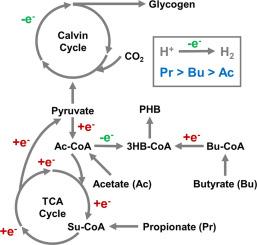当前位置:
X-MOL 学术
›
Water Res.
›
论文详情
Our official English website, www.x-mol.net, welcomes your
feedback! (Note: you will need to create a separate account there.)
Propionic Acid Enhances H2 Production in Purple Phototrophic Bacteria: Insights into Carbon and Reducing Equivalent Allocation
Water Research ( IF 11.4 ) Pub Date : 2024-11-16 , DOI: 10.1016/j.watres.2024.122799 Peitian Huang, Yun Chen, Siwei Yu, Yan Zhou
Water Research ( IF 11.4 ) Pub Date : 2024-11-16 , DOI: 10.1016/j.watres.2024.122799 Peitian Huang, Yun Chen, Siwei Yu, Yan Zhou

|
Biohydrogen is gaining popularity as a clean and cost-effective energy source. Among the various production methods, photo fermentation (PF) with purple phototrophic bacteria (PPB) has shown great opportunity due to its high hydrogen yield. In practice, this yield is influenced by several factors, with the carbon source, particularly simple organic acid, being a key element that has attracted considerable research interest. Short-chain volatile fatty acids (VFAs), such as acetate, propionate, and butyrate, are widely found in waste streams and dark fermentation (DF) effluent. However, most studies on these VFAs focus mainly on performance evaluation, with few exploring the underlying mechanisms, which limits their applicability in real-world scenarios. To uncover the metabolic mechanisms, this study uses metagenomics to clarify the processes of reducing power production and distribution during substrate assimilation. Meanwhile, this study presents the impact of short-chain VFAs on biohydrogen, polyhydroxyalkanoates (PHA) and glycogen production by PPB. The results show that: (1) over long-term cultivation at similar COD consumption rates of 0.06 g COD/d, PPB possessed the highest hydrogen yield when fed with propionate (0.620 L H2·g COD-1) compared with butyrate (0.434) and acetate (0.361); (2) with propionate as the substrate, PPB accumulated less PHA (7% of dry biomass) but more glycogen content (11%), compared to butyrate (15% PHA and 8% glycogen) and acetate (21% PHA and 5% glycogen); (3) metagenomic analysis revealed that propionate resulted in the highest amounts of reducing equivalents, followed by butyrate and acetate; hydrogen production was the most efficient pathway for utilizing the reducing power with propionate, as the CO2 fixation and PHA or glycogen synthesis were ineffective for electron dissipation. This study offers insights into metabolic mechanism that could guide waste stream selection and pretreatment processes to provide favorable VFAs for the PF process, thereby enhancing PPB biohydrogen production performance in practical applications.
中文翻译:

丙酸增强紫色光养细菌中的 H2 产生:深入了解碳和减少等效分配
生物氢作为一种清洁且具有成本效益的能源越来越受欢迎。在众多生产方法中,紫色光养细菌 (PPB) 的光发酵 (PF) 由于其高产氢率而显示出巨大的机会。在实践中,这种产量受多种因素的影响,其中碳源,尤其是简单有机酸,是引起相当大研究兴趣的关键元素。短链挥发性脂肪酸 (VFA),如乙酸盐、丙酸盐和丁酸盐,广泛存在于废物流和暗发酵 (DF) 废水中。然而,关于这些 VFA 的大多数研究主要集中在性能评估上,很少有人探索其潜在机制,这限制了它们在现实世界中的适用性。为了揭示代谢机制,本研究使用宏基因组学来阐明底物同化过程中减少电力产生和分配的过程。同时,本研究介绍了短链 VFA 对 PPB 产生的生物氢、多羟基脂肪酸酯 (PHA) 和糖原的影响。结果表明:(1) 在相似的 0.06 g COD/d 消耗率下长期培养中,PPB 在投喂丙酸盐 (0.620 L H2·g COD-1) 时比丁酸盐 (0.434) 和乙酸盐 (0.361);(2) 以丙酸盐为底物,与丁酸盐(15% PHA 和 8% 糖原)和乙酸盐(21% PHA 和 5% 糖原)相比,PPB 积累的 PHA 较少(干生物量的 7%),但糖原含量较高 (11%);(3) 宏基因组分析显示,丙酸盐导致还原当量最高,其次是丁酸盐和乙酸盐;制氢是利用丙酸盐还原能力的最有效途径,因为 CO2 固定和 PHA 或糖原合成对电子耗散无效。本研究提供了对代谢机制的见解,可以指导废物流的选择和预处理过程,为 PF 工艺提供有利的 VFA,从而提高 PPB 生物氢在实际应用中的生产性能。
更新日期:2024-11-16
中文翻译:

丙酸增强紫色光养细菌中的 H2 产生:深入了解碳和减少等效分配
生物氢作为一种清洁且具有成本效益的能源越来越受欢迎。在众多生产方法中,紫色光养细菌 (PPB) 的光发酵 (PF) 由于其高产氢率而显示出巨大的机会。在实践中,这种产量受多种因素的影响,其中碳源,尤其是简单有机酸,是引起相当大研究兴趣的关键元素。短链挥发性脂肪酸 (VFA),如乙酸盐、丙酸盐和丁酸盐,广泛存在于废物流和暗发酵 (DF) 废水中。然而,关于这些 VFA 的大多数研究主要集中在性能评估上,很少有人探索其潜在机制,这限制了它们在现实世界中的适用性。为了揭示代谢机制,本研究使用宏基因组学来阐明底物同化过程中减少电力产生和分配的过程。同时,本研究介绍了短链 VFA 对 PPB 产生的生物氢、多羟基脂肪酸酯 (PHA) 和糖原的影响。结果表明:(1) 在相似的 0.06 g COD/d 消耗率下长期培养中,PPB 在投喂丙酸盐 (0.620 L H2·g COD-1) 时比丁酸盐 (0.434) 和乙酸盐 (0.361);(2) 以丙酸盐为底物,与丁酸盐(15% PHA 和 8% 糖原)和乙酸盐(21% PHA 和 5% 糖原)相比,PPB 积累的 PHA 较少(干生物量的 7%),但糖原含量较高 (11%);(3) 宏基因组分析显示,丙酸盐导致还原当量最高,其次是丁酸盐和乙酸盐;制氢是利用丙酸盐还原能力的最有效途径,因为 CO2 固定和 PHA 或糖原合成对电子耗散无效。本研究提供了对代谢机制的见解,可以指导废物流的选择和预处理过程,为 PF 工艺提供有利的 VFA,从而提高 PPB 生物氢在实际应用中的生产性能。


















































 京公网安备 11010802027423号
京公网安备 11010802027423号